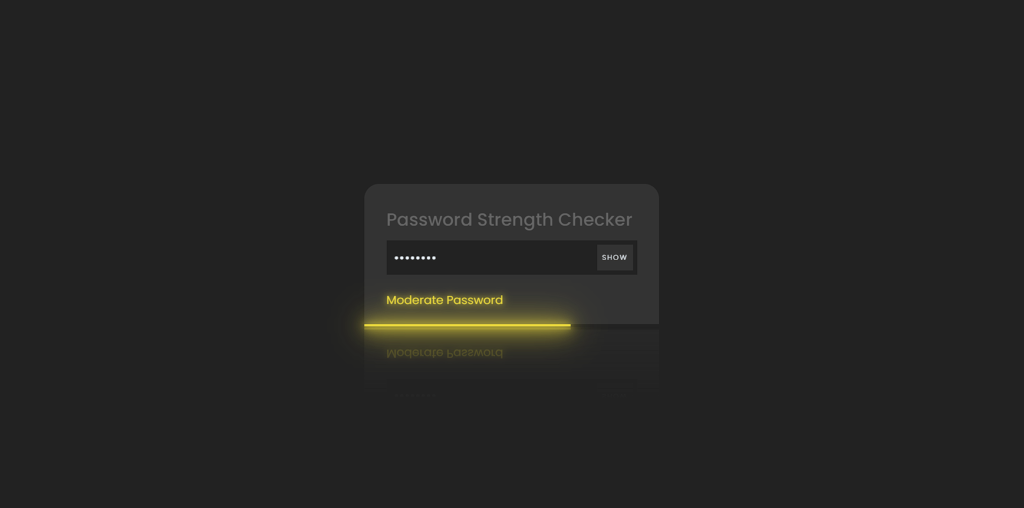Let’s make a Glowing Password Strength Checker using HTML, CSS, and JavaScript. This project is great for beginners and will help you learn how to create a useful tool.
We’ll use HTML to set up the basic structure, CSS to make it look nice, and JavaScript to make the generator work. No need for anything fancy – just simple coding!
Let’s start building this Password Strength Checker. It’s perfect for anyone who wants to learn coding or needs a handy tool. Let’s begin and make generating passwords easy!
HTML :
The provided code is an HTML document that creates a password strength checker. It consists of a container with a heading, an input area for entering a password, a show/hide password toggle, and a strength meter. The JavaScript file script.js is responsible for checking the strength of the entered password and updating the strength meter accordingly. The CSS file style.css is used to style the elements in the document.
<!DOCTYPE html>
<html lang="en" >
<head>
<meta charset="UTF-8">
<title> Glowing Password Strength Checker</title>
<link rel="stylesheet" href="./style.css">
</head>
<body>
<!-- partial:index.partial.html -->
<div class="container">
<h2>Password Strength Checker</h2>
<div class="inputArea">
<input type="password" placeholder=" Password" id="YourPassword">
<div class="show"></div>
</div>
<div class="strengthMeter"></div>
</div>
<!-- partial -->
<script src="./script.js"></script>
</body>
</html>
CSS :
The provided CSS code is responsible for styling the password strength checker HTML document. The container element is styled with a dark background, padding, and border radius. The input area has a dark background and no border, and the strength meter is positioned at the bottom with different styles based on the strength of the password. The show/hide password toggle is positioned at the top right corner. The CSS code also includes styles for different password strength levels and their corresponding messages.
@import url("https://fonts.googleapis.com/css2?family=Poppins:wght@100;200;300;400;500;600;700;800;900&display=swap");
* {
margin: 0;
padding: 0;
box-sizing: border-box;
font-family: "Poppins", sans-serif;
}
body {
display: flex;
align-items: center;
justify-content: center;
min-height: 100vh;
background: #222;
}
.container {
position: relative;
width: 400px;
border-radius: 20px 20px 0 0;
padding: 30px;
background: #333;
display: flex;
justify-content: center;
/* align-items: center; */
flex-direction: column;
border-radius: 1px solid #111;
gap: 10px;
padding-bottom: 70px;
-webkit-box-reflect: below 1px
linear-gradient(transparent, transparent, #0005);
}
.container h2 {
color: #666;
font-weight: 500;
}
.container .inputArea {
position: relative;
width: 100%;
}
.container .inputArea input {
position: relative;
width: 100%;
background: #222;
border: none;
outline: none;
padding: 10px;
color: aliceblue;
font-size: 1.1em;
}
.container .strengthMeter {
position: absolute;
left: 0;
bottom: 0;
width: 100%;
height: 3px;
background: #222;
}
.container .strengthMeter::before {
content: "";
position: absolute;
width: 0;
height: 100%;
transition: 0.5s;
background: #f00;
}
.container.weak .strengthMeter::before {
width: 10%;
background: #f00;
filter: drop-shadow(0 0 5px #f00) drop-shadow(0 0 10px #f00)
drop-shadow(0 0 20px #f00);
}
.container.moderate .strengthMeter::before {
width: 70%;
background: #eedc3d;
filter: drop-shadow(0 0 5px #eedc3d) drop-shadow(0 0 10px #eedc3d)
drop-shadow(0 0 20px #eedc3d);
}
.container.strong .strengthMeter::before {
width: 100%;
background: #18e605;
filter: drop-shadow(0 0 5px #18e605) drop-shadow(0 0 10px #18e605)
drop-shadow(0 0 20px #18e605);
}
.container .strengthMeter::after {
position: absolute;
top: -45px;
left: 30px;
transition: 0.5s;
color: aliceblue;
}
.container.container.weak .strengthMeter::after {
content: "Weak Password";
color: #f00;
filter: drop-shadow(0 0 5px#f00);
}
.container.container.container.moderate .strengthMeter::after {
content: "Moderate Password";
color: #eedc3d;
filter: drop-shadow(0 0 5px#eedc3d);
}
.container.container.container.container.strong .strengthMeter::after {
content: "Strong Password";
color: #18e605;
filter: drop-shadow(0 0 5px#18e605);
}
.show {
position: absolute;
top: 0;
right: 0;
width: 60px;
height: 100%;
background: #333;
border: 6px solid #222;
cursor: pointer;
justify-content: center;
align-items: center;
display: flex;
}
.show::before {
content: "Show";
font-size: 0.6em;
color: aliceblue;
letter-spacing: 0.15em;
text-transform: uppercase;
}
.show.hide::before {
content: "Hide";
}
JavaScript:
The code adds an event listener to the document that triggers the password strength check whenever a key is released in the password input field. The password strength is calculated using the Strength function, and the container element’s class is updated based on the strength level. The class determines the styling of the strength meter.
function Strength(password) {
let i = 0;
if (password.length > 6) {
i++;
}
if (password.length >= 10) {
i++;
}
if (/[A-Z]/.test(password)) {
i++;
}
if (/[0-9]/.test(password)) {
i++;
}
if (/[A-Za-z0-8]/.test(password)) {
i++;
}
return i;
}
let container = document.querySelector(".container");
document.addEventListener("keyup", function (e) {
let password = document.querySelector("#YourPassword").value;
let strength = Strength(password);
if (strength <= 2) {
container.classList.add("weak");
container.classList.remove("moderate");
container.classList.remove("strong");
} else if (strength >= 2 && strength <= 4) {
container.classList.remove("weak");
container.classList.add("moderate");
container.classList.remove("strong");
} else {
container.classList.remove("weak");
container.classList.remove("moderate");
container.classList.add("strong");
}
});
let password = document.querySelector("#YourPassword");
let show = document.querySelector(".show");
show.onclick = function () {
if (password.type === "password") {
password.setAttribute("type", "text");
show.classList.add("hide");
} else {
password.setAttribute("type", "password");
show.classList.remove("hide");
}
};
In conclusion, creating a Password Strength Checker using HTML, CSS, and JavaScript is a fantastic way to learn coding while building a useful tool. By using simple words and basic coding techniques, beginners can easily follow along and gain valuable skills.
If your project has problems, don’t worry. Just click to download the source code and face your coding challenges with excitement. Have fun coding!
